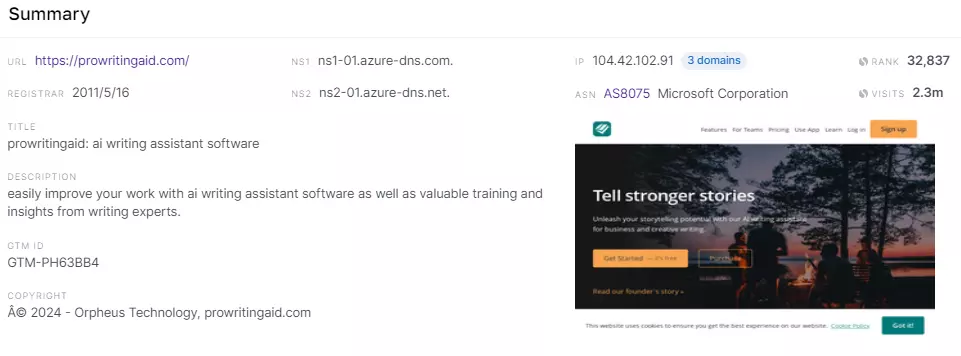
The ongoing debate between ProWritingAid and Grammarly continues, whether you're a writer or a student. While Grammarly proves to be versatile for all types of writing, ProWritingAid finds its niche in the realm of fictional writing.
However, this is not the only difference between these two writing tools.
In this comprehensive comparison, we will delve into the strengths and weaknesses of ProWritingAid and Grammarly to help you make an informed decision tailored to your specific writing needs.
What is ProWritingAid?
ProWritingAid is a writing assistant that goes beyond traditional grammar and spelling checks, providing users with an extensive analysis of their writing style.
Established in 2011, ProWritingAid has 2.3 million visitors per month. (Data from Niche Finder's Website Audit)

Let's explore some key features that set ProWritingAid apart:
1. Style and Structure Analysis: ProWritingAid offers suggestions to improve the structure and style of your writing. It evaluates sentence length, variety, and overall flow, aiming to enhance the overall readability and engagement of your content.
2. Real-time Editing: Similar to Grammarly, ProWritingAid offers real-time editing as you type. The tool underlines errors and provides suggestions, allowing you to make corrections on the fly.
3. In-depth Reports: One of ProWritingAid's strengths lies in its detailed reports. It provides comprehensive insights into various aspects of your writing, including grammar, style, readability, overused words, and more. This can be particularly helpful for writers looking to refine their craft.
4. Readability Analysis: ProWritingAid assigns a readability score to your content, helping you tailor your writing to a specific audience. This feature ensures that your writing is not only error-free but also suitable for your target readers.
For more details, please read our full reviews on Prowritingaid.
What is Grammarly?
Grammarly has gained widespread popularity for its user-friendly interface and robust grammar-checking capabilities.
Here are some key aspects that make Grammarly a formidable writing companion:
1. User-Friendly Interface: Grammarly boasts a simple and intuitive interface, making it accessible to users of all writing levels. Its browser extensions, desktop applications, and integrations with various platforms ensure a seamless writing experience.
2. Advanced Grammar Checking: Grammarly excels in basic grammar checking, offering suggestions for common errors such as punctuation, subject-verb agreement, and sentence structure. Its algorithms are adept at catching nuanced grammatical issues.
3. Integration and Compatibility: Grammarly seamlessly integrates with a wide range of platforms, including web browsers, Microsoft Word, Google Docs, and more. This ensures that you can access Grammarly wherever you write.
4. Vocabulary Enhancement: In addition to grammar, Grammarly provides vocabulary suggestions to enhance the richness and variety of your writing. This feature is valuable for those seeking to elevate their language use.
Key Differences Between ProWritingAid vs Grammarly
Here are the four most significant distinctions between ProWritingAid and Grammarly:
1. Quality of Analysis
ProWritingAid sets itself apart with a comprehensive analysis, offering 20 different writing reports. It goes beyond merely identifying errors and actively helping users enhance the style and structure of their writing.
On the other hand, Grammarly primarily focuses on catching fundamental mistakes such as grammar and punctuation. While it can transform subpar writing into decent prose, it may not be as geared towards making profound improvements that elevate decent writing to greatness.
2. Long-Form Content
ProWritingAid proves to be more convenient for handling longer content, especially for writers working on extensive projects like books.
Grammarly necessitates manual copying and pasting of each section into the app for longer content. Grammarly's software experiences a notable slowdown after passing the 10,000-word mark, maxing out around 20,000 words.
In contrast, ProWritingAid efficiently scans up to 100,000 words without significant speed reduction. This capability, coupled with integrations with apps like Scrivener and Final Draft, makes ProWritingAid particularly popular among fiction writers.
It seamlessly integrates with Microsoft Word and various writing apps, offering a smoother writing experience.
3. Educational Materials
ProWritingAid distinguishes itself by providing extensive educational materials within the platform.
Unlike Grammarly, it offers in-app explanations for each suggestion, enabling users to understand the root of the issue.
Educational resources include videos on grammar rules, quizzes, and a Writer’s Resource library filled with articles and eBooks. ProWritingAid not only helps users rectify errors but also aids in building long-term writing skills through educational support.
4. Price
In terms of affordability and value for money, ProWritingAid emerges as the more economical choice. Both ProWritingAid and Grammarly offer free versions with basic features, but to access advanced tools, users need to upgrade to the premium plans.
ProWritingAid's Premium plan offers access to every report even in the free version, albeit with a word count limit of 500 words. In comparison, Grammarly's Premium version comes with three payment plans:
Monthly at $30
Quarterly at $20/month billed as $60
Annual at $12/month billed as $144
ProWritingAid's Premium plan is more budget-friendly, and there's an additional discount for students. Users can opt for a free trial before committing to the yearly subscription, making ProWritingAid a cost-effective choice that delivers more value for a relatively lower price compared to Grammarly's annual plan.
Final Words on Prowritingaid Vs Grammarly
Choosing between ProWritingAid and Grammarly ultimately depends on your specific writing goals and preferences.
If you prioritize in-depth writing analysis, style refinement, and a comprehensive approach to improving your writing, ProWritingAid may be the better choice.
On the other hand, if you value accuracy in grammar checking, a user-friendly interface, and widespread compatibility, Grammarly might be the preferred option.
Consider your writing style, the level of detail you seek in feedback, and your budget when making a decision.

